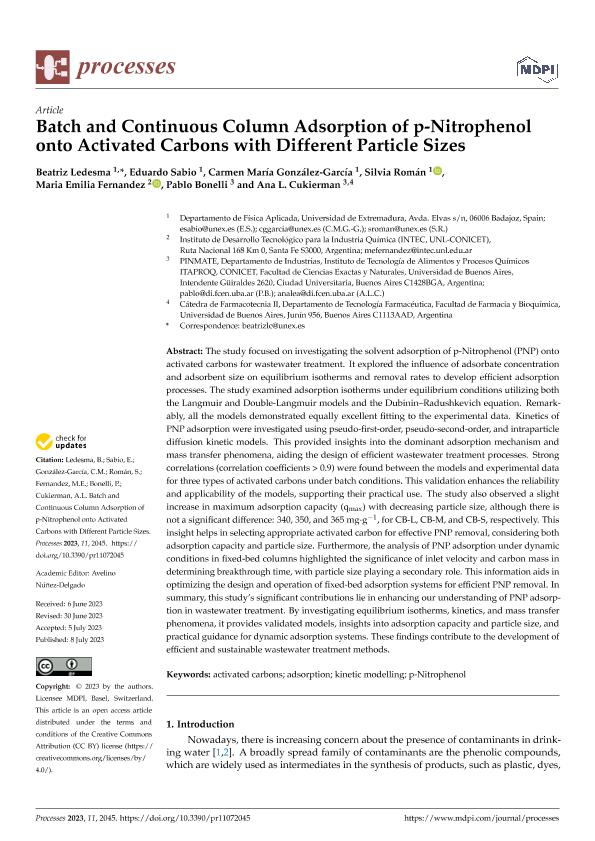Artículo
Batch and Continuous Column Adsorption of p-Nitrophenol onto Activated Carbons with Different Particle Sizes
Ledesma, Beatriz; Sabio, Eduardo; González García, Carmen María; Román, Silvia; Fernandez, Maria Emilia ; Bonelli, Pablo Ricardo
; Bonelli, Pablo Ricardo ; Cukierman, Ana Lea
; Cukierman, Ana Lea
 ; Bonelli, Pablo Ricardo
; Bonelli, Pablo Ricardo ; Cukierman, Ana Lea
; Cukierman, Ana Lea
Fecha de publicación:
07/2023
Editorial:
Multidisciplinary Digital Publishing Institute
Revista:
Processes
e-ISSN:
2227-9717
Idioma:
Inglés
Tipo de recurso:
Artículo publicado
Clasificación temática:
Resumen
The study focused on investigating the solvent adsorption of p-Nitrophenol (PNP) onto activated carbons for wastewater treatment. It explored the influence of adsorbate concentration and adsorbent size on equilibrium isotherms and removal rates to develop efficient adsorption processes. The study examined adsorption isotherms under equilibrium conditions utilizing both the Langmuir and Double-Langmuir models and the Dubinin–Radushkevich equation. Remarkably, all the models demonstrated equally excellent fitting to the experimental data. Kinetics of PNP adsorption were investigated using pseudo-first-order, pseudo-second-order, and intraparticle diffusion kinetic models. This provided insights into the dominant adsorption mechanism and mass transfer phenomena, aiding the design of efficient wastewater treatment processes. Strong correlations (correlation coefficients > 0.9) were found between the models and experimental data for three types of activated carbons under batch conditions. This validation enhances the reliability and applicability of the models, supporting their practical use. The study also observed a slight increase in maximum adsorption capacity (qmax) with decreasing particle size, although there is not a significant difference: 340, 350, and 365 mg·g−1, for CB-L, CB-M, and CB-S, respectively. This insight helps in selecting appropriate activated carbon for effective PNP removal, considering both adsorption capacity and particle size. Furthermore, the analysis of PNP adsorption under dynamic conditions in fixed-bed columns highlighted the significance of inlet velocity and carbon mass in determining breakthrough time, with particle size playing a secondary role. This information aids in optimizing the design and operation of fixed-bed adsorption systems for efficient PNP removal. In summary, this study’s significant contributions lie in enhancing our understanding of PNP adsorption in wastewater treatment. By investigating equilibrium isotherms, kinetics, and mass transfer phenomena, it provides validated models, insights into adsorption capacity and particle size, and practical guidance for dynamic adsorption systems. These findings contribute to the development of efficient and sustainable wastewater treatment methods.
Palabras clave:
ACTIVATED CARBONS
,
ADSORPTION
,
KINETIC MODELLING
,
P-NITROPHENOL
Archivos asociados
Licencia
Identificadores
Colecciones
Articulos(ITAPROQ)
Articulos de INSTITUTO DE TECNOLOGIA DE ALIMENTOS Y PROCESOS QUIMICOS
Articulos de INSTITUTO DE TECNOLOGIA DE ALIMENTOS Y PROCESOS QUIMICOS
Citación
Ledesma, Beatriz; Sabio, Eduardo; González García, Carmen María; Román, Silvia; Fernandez, Maria Emilia; et al.; Batch and Continuous Column Adsorption of p-Nitrophenol onto Activated Carbons with Different Particle Sizes; Multidisciplinary Digital Publishing Institute; Processes; 11; 7; 7-2023; 1-22
Compartir
Altmétricas



